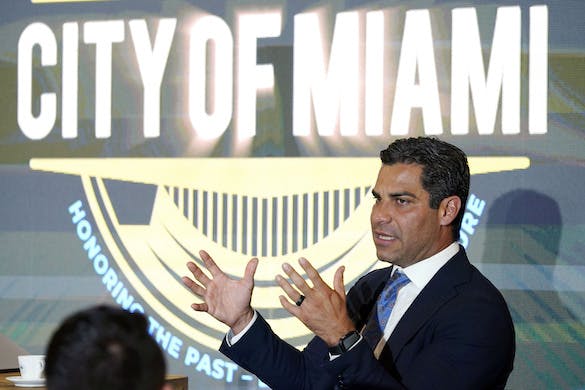Regulations Stymie New York in Crypto Competition vs. Miami
New York’s BitLicense regulatory regime is the most onerous in the country. Introduced in 2015 and touted as a nationwide model, it has failed spectacularly.

New York City and Miami are the clear frontrunners to become the preeminent home of American cryptocurrency, and the cities’ mayors — Eric Adams of New York and Francis Suarez of Miami — are already engaged in a friendly rivalry.
New York is clearly at a disadvantage, though, as state-level policies will stymie Mr. Adams’s quest unless officials in Albany reverse suffocating regulation and zealous prosecutions.
Both Messrs. Adams and Suarez have touted their credentials by promising to accept an increasing number of paychecks in Bitcoin — Mr. Adams remaining steadfast despite the recent market collapse that reportedly cost him $1,000. In Florida, Mr. Suarez is aided by a deregulation-minded governor.
Other governors and mayors seeking to join the crypto race would be smart to follow Florida’s lead.
Already, Mr. Suarez has introduced pro-crypto policies, including so-called MiamiCoin. The city began “staking” its cryptocurrency in August 2021. Staking is a mechanism of pooling crypto holdings and earning yields. The revenue produced, if annualized, amounts to $21 million. The mayor says the city will return this money to residents in the form of a Bitcoin yield through digital wallets.
Mr. Adams, meanwhile, says he wants the Big Apple to be a “crypto friendly city” and vows to “look at what’s preventing the growth of Bitcoin and cryptocurrency in our city.”
He need not look far. New York’s BitLicense regulatory regime is the most onerous in the country.
Introduced in 2015 and touted as a nationwide model, it has failed spectacularly. Of the 20 companies that have received the license, most are multibillion-dollar concerns. BitLicence holder Bitstamp relayed word of a four-year application process, and others have described 1,000-page, double-sided applications and $100,000 in compliance costs.
Some crypto-based companies, including Shapeshift, decamped immediately. Shapeshift’s chief executive stated, “We either would have to do something we’re not comfortable with or leave New York. It’s a moral and ethical stand we’re going take.”
The virtual marketplace Nexo installed geo-blocking technology that keeps New Yorkers out.
Corporate precaution hasn’t stopped New York’s government from banning or investigating companies. The state’s attorney general, Letitia James, recently announced bans of Nexo and another virtual marketplace, Celsius, claiming the interest and yields they provide on deposits classifies them as securities dealers and thus they must meet an array of compliance mandates created for a long-ago world.
Perversely, New York views the same staking-type activity that Miami is using to reduce resident tax burdens as a prosecutable offense in the name of investor protection. Yet, it is difficult to see whom Ms. James is protecting.
Both companies are well capitalized and insured. Celsius has $26.4 billion in assets and has paid out more than $930 million in yields and rewards. Nexo has paid out more than $50 million to its 2 million users worldwide and has military-grade security.
If successful, Ms. James would likely force these marketplaces out of the state with stiff fines, as happened with stablecoin issuer Tether. The largest stablecoin by volume, Tether claims to have left America altogether, citing regulatory headaches.
A New York without Nexo, Celsius, or similar marketplaces would leave residents in and out of the city worse off. Virtual crypto marketplaces provide the less fortunate with the ability to borrow against holdings and earn impressive interest rates on deposits, helping them climb the economic ladder.
The stablecoin interest that these marketplaces provide can potentially boost incomes of New Yorkers living month-to-month, though these residents, like anyone else, would need to weigh the risks. Crypto marketplaces command interest rates approaching 9 percent or higher on an annual percentage yield, because they provide value in the crypto ecosystem that exceeds their dollar-pegged book value (including efficient trading liquidity and a safe harbor in moments of heightened crypto volatility).
As such, the stablecoin market has exploded, and now exceeds $178 billion. “Traditional” crypto trades lower interest rates for a chance at huge returns. People who bought Bitcoin with their April 2020 $1,200 stimulus check at one point would have had $11,000, and that doesn’t include a year’s worth of 4 percent to 5 percent in annual percentage yields.
As crypto goes mainstream, elected officials are going to have to choose whether to follow the New York or Florida model. It should be an easy choice: Pledges to take one’s salary in Bitcoin mean little if local or state governments simultaneously try to thwart the industry and deprive citizens of easy passive income in the name of protecting them.
